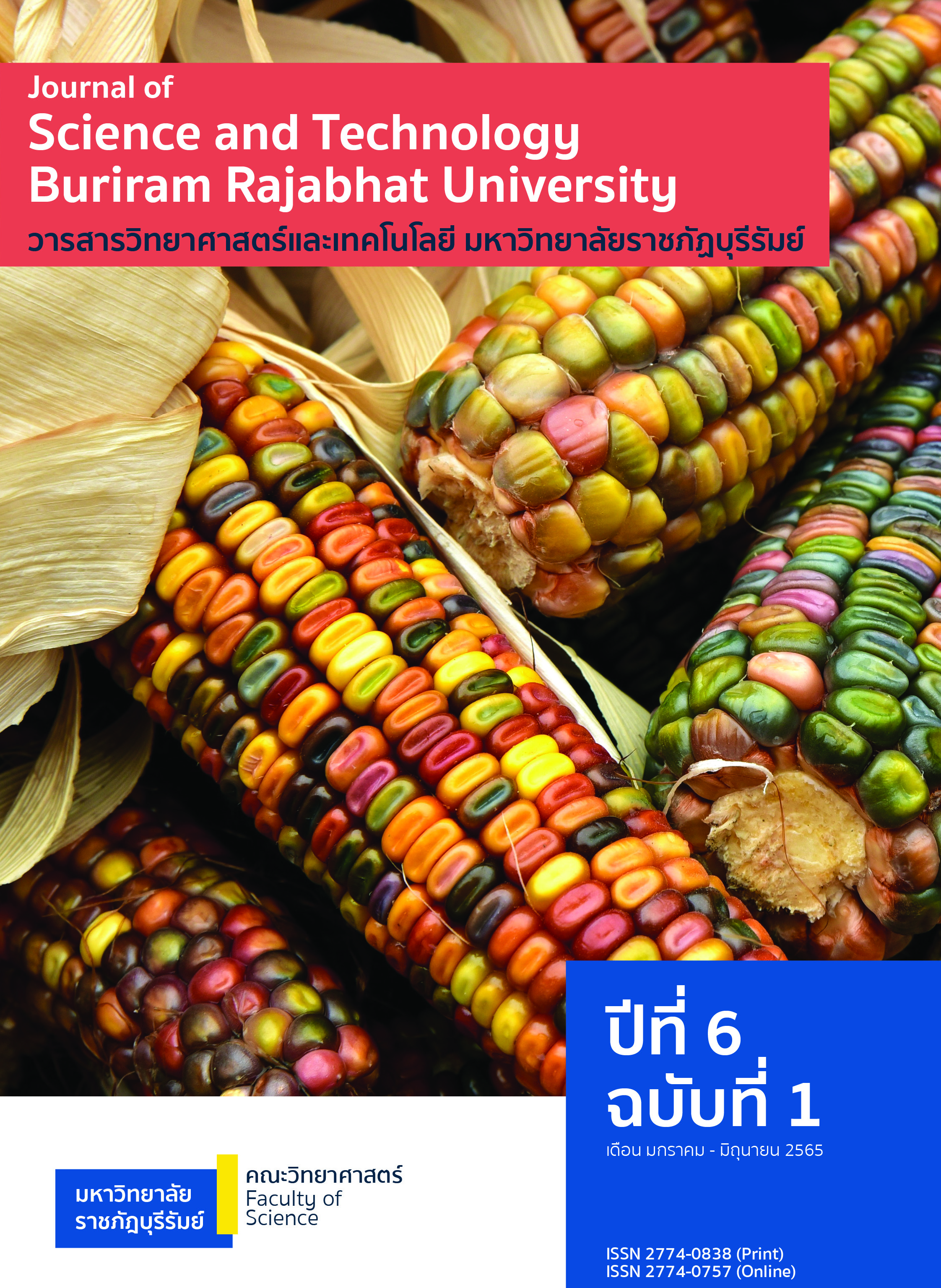เซนเซอร์แสงของฟิล์ม TiO2 ที่เจือด้วย Al2O3 ที่เตรียมด้วยเผาผนึกสาร
Main Article Content
บทคัดย่อ
เซนเซอร์แสงเป็นอุปกรณ์อิเล็กทรอนิกส์ที่ใช้การเปลี่ยนแปลงความต้านทานไฟฟ้าเมื่อฉายแสง สาร TiO2 มีคุณสมบัติเป็นสารกึ่งตัวนำ มีความต้านทานไฟฟ้าสูง และเป็นตัวเร่งปฏิกิริยาทางแสงที่ดี และ Al2O3 ที่มีความโปร่งใสยอมให้แสงผ่านได้ และนำไฟฟ้าได้ เมื่อฉายแสงลงบนพื้นผิวของสารกึ่งตัวนำจะทำให้ความต้านทานลดลงเนื่องจากทำให้เกิดออกซิเจนที่พื้นผิวหลุดออกเป็นผลให้เกิดช่องว่างของออกซิเจน (oxygen vacancy) ในงานวิจัยนี้ได้นำสาร TiO2 ที่เจือด้วย Al2O3 5 % โดยโมล นำไปเผาผนึกสารที่อุณหภูมิ 900, 950 และ 1,000°C แล้วเคลือบฟิล์มบนกระจกนำไฟฟ้าด้วยเทคนิค spin coating จากนั้นทำการศึกษา ลักษณะของเฟสของสารตัวอย่าง พบว่า เมื่อเผาผนึกสารที่อุณหภูมิสูงขึ้น จะมีระนาบของ TiO2 และ AlTiO2 ที่มีพีคที่สูงขึ้นด้วยเทคนิค XRD และจากภาพถ่ายเทคนิค SEM จะเห็นว่าขนาดของอนุภาคใหญ่ขึ้น จะมีความต้านทานไฟฟ้าต่ำลง จากการศึกษาการฉายแสงอาทิตย์จำลอง 1000 W/m2 บนพื้นผิวของฟิล์มบางทำให้มีความต้านทานลดลง และเมื่อปิดแสงทำให้มีความต้านทานเพิ่มขึ้น แต่ความต้านทานจะไม่ขึ้นมาเท่าเดิม และมีแนวโน้มของความต้านทานลดลงจนอิ่มตัว สำหรับฟิล์มบาง 900°C มีช่วงการเปลี่ยนแปลงความต้านทานมากที่สุด ซึ่งเป็นช่วงที่กว้าง ดังนั้น ฟิล์มบางของ TiO2 ที่เจือด้วย Al2O3 จึงเหมาะสมต่อการประดิษฐ์เป็นเซนเซอร์แสงได้
Article Details

อนุญาตภายใต้เงื่อนไข Creative Commons Attribution-NonCommercial-NoDerivatives 4.0 International License.
เนื้อหาและข้อมูลในบทความที่ลงตีพิมพ์ในวารสารวารสารวิทยาศาสตร์และเทคโนโลยีถือเป็นข้อคิดเห็นและความรับผิดชอบของผู้เขียนบทความโดยตรงซึ่งกองบรรณาธิการวารสาร ไม่จำเป็นต้องเห็นด้วย หรือร่วมรับผิดชอบใด ๆ
บทความ ข้อมูล เนื้อหา รูปภาพ ฯลฯ ที่ได้รับการตีพิมพ์ในวารสารวารสารวิทยาศาสตร์และเทคโนโลยีถือเป็นลิขสิทธิ์ของวารสารวารสารวิทยาศาสตร์และเทคโนโลยีหากบุคคลหรือหน่วยงานใดต้องการนำทั้งหมดหรือส่วนหนึ่งส่วนใดไปเผยแพร่ต่อหรือเพื่อกระทำการใด ๆ จะต้องได้รับอนุญาตเป็นลายลักษณ์อักษรจากวารสารวารสารวิทยาศาสตร์และเทคโนโลยี ก่อนเท่านั้น
เอกสารอ้างอิง
membranes for environmental applications. Applied Catalysis B: Environmental, 63(1-2), 60-67.
Kope, B. M., Park, S. G., Lee, H. D. & Nishi, Y. (2012). First principles calculations of oxygen vacancy-ordering effects in resistance change
memory materials incorporating binary transition metal oxides. Journal of Material Science, 47, 7498-7514.
Meevasana, W., King, P. D. C., He, R. H., Mo, S.-K., Hashimoto, M., Tamai, A., Songsiriritthigul, P., Baumberger, F. & Shen, Z.-X. (2011). Creation
and control of a two-dimentional electron liquid at the bare SrTiO3 surface. Nature Materials, 10, 114-118.
Senain, I., Nayan, N. & Saim, H. (2010). Structural and Electrical Properties of TiO2 Thin Film Derived from Sol-gel Method using Titanium (IV)
Butoxide. International Journal of Integrated Engineering, 2(3):29-35.
Sugumaran, S. & Bellan, C.S. (2014). Transparent nano composite PVA–TiO2 and PMMA–TiO2 thin films: Optical and dielectric properties. Optik,
125(18), 5128-5133.
Suwanwong, S., Eknapakul, T., Rattanacha Y., . Masingboon, C., Rattanasuporn, S., Phatthanakun, R., Nakajima, H., King, P., Hodak, S. &
Meevasana, W. (2015) The dynamics of ultraviolet-induced oxygen vacancy at the surface of insulating SrTiO3. Applied Surface Science, 355,
210-212.
Suwanwong, S., Kullapapinyokul, J., Eknapakul, T., Buaphet, P., Pattanakul, R. & Meevasana w. (2014). Resistivity change in SrTiO3 upon
irradiation and its application in light sensing. Suranaree Journal of Science and Technology, 22(1), 93-98.
Yildiz, A., Lisesivdin S.B., Kasap M., & Mardare D. (2008). Electrical properties of TiO2 thin films. Journal of Non-Crystalline Solids, 254, 4944-4947.
Zhang, H., Zhao, L., Liang, Z. & Han, P. (2012). Effects of oxygen vacancy on the electronic structure and absorption spectra of bismuth
oxychloride. Computational Materials Science, 61, 180–184.


